- Home
- Maurice Magre
The Blood of Toulouse
The Blood of Toulouse Read online
The Blood of Toulouse
by
Maurice Magre
Translated, annotated and introduced by
Brian Stableford
A Black Coat Press Book
TABLE OF CONTENTS
Introduction 4
THE BLOOD OF TOULOUSE 15
PART ONE 19
PART TWO 80
PART THREE 160
THE UNKNOWN MASTER OF THE ALBIGENSIANS 234
FRENCH SCIENCE FICTION & FANTASY COLLECTION 288
Introduction
This is the eighth volume of a twelve-volume set of translations of Maurice Magre’s prose fiction. It contains translations of the novel Le Sang de Toulouse (1931), as “The Blood of Toulouse,” and the chapter from Magiciens et illuminés entitled “Le Maître inconnu des Albigeois,” as “The Secret Master of the Albigensians.”
Volume One, The Marvelous Story of Claire d’Amour and Other Stories, contains translations of early short stories, including the collection Histoire merveilleuse de Claire d’Amour suivie d’autres contes merveilleux (1903) and six other stories from various sources published between 1901 and 1913.
Volume Two, The Call of the Beast and Other Stories, contains translations of his first three works of prose fiction in volume form, Les Colombes poignardées (1917), as “Stabbed Doves,” La Tendre camarade (1918), as “The Tender Comrade” and L’Appel de la bête (1920), as “The Call of the Beast.”
Volume Three, Priscilla of Alexandria and Other Stories contains translations of the original version of the story collection Vies des courtisanes, first published in Oeuvres Libres 23 (1923), as “Courtesans’ Lives” plus the additional story added to the version published in volume form in 1925, and the novel Priscilla d’Alexandrie (1925), as “Priscilla of Alexandria.”
Volume Four, The Angel of Lust, contains translations of the novella, La Vie amoureuse de Messaline (1925), as “The Love Life of Messalina,” the novel published as La Luxure de Grenade (1926), as “The Angel of Lust,” and the chapter from Magiciens et illuminés (1930) entitled “Christian Rosenkreutz et les Rose-croix,” as “Christian Rosenkreutz and the Rosicrucians.”
Volume Five, The Mystery of the Tiger, contains translations of the novella Le Roman de Confucius (1927), as “The Story of Confucius,” and the novel Le Mystère du tigre (1927), as “The Mystery of the Tiger.”
Volume Six, The Poison of Goa, contains translations of the novel Le Poison de Goa (1928), as “The Poison of Goa,” and the prose poems contained in Le Livre des lotus entr’ouverts (1926), as “Lotus Blossoms.”
Volume Seven, Lucifer, contains a translation of the novel originally published under the same title in 1929 and the novella La Nuit de haschich et de l’opium (1929), as “The Night of Hashish and Opium.”
Volume Nine, The Albigensian Treasure, contains translations of the novel Le Trésor des Albigeois (1938) as “The Albigensian Treasure,” and the collection of vignettes “Communication avec la nature” from La Beauté invisible (1937), as “Communication with Nature.”
Volume Ten, Jean de Fodoas, contains translations of the novel Jean de Fodoas: aventures d’un Français à la cour de l’empereur Akbar (1939) as “Jean de Fodoas” and the chapter from Magiciens et illuminés entitled “Le Mystère des Templiers,” as “The Mystery of the Templars.”
Volume Eleven, Melusine, contains translations of the novel Mélusine, ou le secret de solitude (1941) and the collections of vignettes “Le Côté d’ombre des âmes” and “Révélation des mondes invisibles” from La Beauté invisible, as “The Dark Side of Souls” and “The Revelation of Invisible Worlds.”
Volume Twelve, The Brothers of the Virgin Gold, contains a translation of the novel Les Frères de l’or vierge, first published posthumously in 1949.
In the biography Maurice Magre: Le Lotus perdu [Maurice Magre: The Lost Lotus] (1999), Jean-Jacques Bedu only offers vague indications as to the early development of Maurice Magre’s fascination with the history of the Albigensian heresy—also known as the Cathar heresy—and with the legends associated with the ruins of Montségur. That is understandable, given that Magre was vague about the relevant chronology in his own autobiographical writings. In Pourquoi je suis Bouddhiste [Why I am a Buddhist] (1928) he implies that it gripped him in his childhood, but elsewhere he complained about the fact that the “truth” had been hidden from him in that era by conventional historical education. It is, therefore, unclear exactly when he read the three-volume Histoire des Albigeois: Les Albigeois et l’Inquisition (1870-1872) written by Napoléon Peyrat (1809-1881), which revealed to him the falsity of the orthodox account and set him firmly in the path to inventing his own interpretation of what had been at stake in the extirpation of the heresy.
Although Magre had certainly begun elaborating his own “secret history” of mysticism and magic by the time he wrote Priscilla d’Alexandrie (1925), the incorporation thereinto of the Albigensian heresy as a crucial linchpin probably post-dated the writing of La Luxure de Grenade (1926), which does not make a connection between Christian Rosenkreutz and the heresy in question. It was probably not long before he produced his idiosyncratic version of the hermetic tradition, as outlined in Magiciens et illuminés [Magicians and Illuminati], that he invented the account of the Albigensians beliefs translated as an appendix to the present volume. Magiciens et illuminés was published in 1930 by Fasquelle, shortly before his Confessions sur les femmes, l’opium, l’amour, l’idéal, etc... [Confessions regarding Women, Opium, Amour and the Ideal, etc.], which was issued in the same year (the latter includes the former in its list of the author’s previous works, while the former does not include the latter).
Whenever he read it, however, Peyrat’s “history” obviously had a tremendous impact on Magre’s imagination, in the same way that reading Madame Blavatsky’s account of The Secret Doctrine had done, probably a few years earlier. Having written the long chapter on the Albigensians in Magiciens et illuminés and completed his Confessions he must have begun almost immediately to write a novel in the vein of his previous historical melodramas, based on his own elaboration of Peyrat’s scholarly fantasy, with a sense of personal involvement all the greater because he was writing about his own native city and is evolution.
The depiction of the Albigensian crusade presented in the elaborate essay in Magiciens et illuminés is largely second-hand, almost entirely derived from Peyrat—as is acknowledged, albeit scantily, in the references appended to the article—although Magre elaborated the borrowed material substantially even there, and he went on to elaborate it even further in Le Sang de Toulouse (1931), which presents a first-person account of the entire history of the destruction of the Albigensian heresy, over half a century. The narrator, Dalmas Rochemaure, is ingeniously credited by the author with an active role in all of the key incidents of the history, and although many sections of the narrative are necessarily synoptic, Magre shows great artistry in collapsing such an extensive story into a manageable text, supplying adequate background information without overburdening the story with factual detail.
The notion that his native city and the area surrounding it—of which Magre remained passionately fond even though he had deserted it for Paris in the pursuit of his literary vocation and had only recently returned to live in the Midi in 1930—had a secret history, long-buried by the “official” history that represented the Church’s crusade against the Albigensians merely as an incident in the unification of France as a nation, was tailor-made to attract his attention and his affiliation, and he embraced it wholeheartedly. However, Peyrat’s work, although highly inventive, was not entirely original either, and the fantasization of the history of Toulouse had already begun, in a work of which Magre was undoubtedly
unaware, but the existence of which nevertheless serves to situate Le Sang de Toulouse within an eccentric and elaborate long-standing tradition
Although Peyrat’s account of the last stand of the surviving Albigensian perfecti in the castle of Montségur, allegedly built by Esclarmonde de Foix—of whom little was reliably known save for her name, but whom Peyrat made into a symbolic heroine and a kind of guiding light of Catharism—is a fabulous romantic invention, due almost entirely to his own imagination, the remainder of his history is based in large part on a previous work that was thought at the time to be a reliable history, although twentieth-century investigation has revealed that it too contained a strong dose of scholarly fantasy: Étienne de Lamothe-Langon’s three-volume Histoire de l’Inquisition en France (1829). Lamothe-Langon claimed to have based much of his account on archives preserved in his native city, Toulouse, and several sets of Annales de la ville de Toulouse had, indeed, been published in 1687, 1772 and 1776, but those documents consisted of little more than lists of names of people holding public and religious offices at various times. Lamothe-Langon invented stories to go with many of the names, primarily in order to illustrate the horrors of the Inquisition, although he remained broadly neutral with regard to the supposed substance of Albigensian heresy and treated Simon de Monfort and his genocidal crusaders in a broadly respectful fashion, save for disapproving of the massacres they carried out.
Lamothe-Langon had earlier written 459 articles for the Biographie Toulousaine (1823) and had also published a Biographie des préfets des 87 départements de la France, par un sous-préfet (1826), but nobody seems to have bothered to investigate the extent to which those texts are polluted by invention. Later in his career, however, he went on to become a prolific writer of fake memories and biographies, beginning with a best-selling six-volume set of the memoirs of the notorious Comtesse Du Barry (1829-30), which recycled material from his historical novel Le Chancelier et les censeurs [The Chancellor and the Censors] (1828) as well as material borrowed from earlier fictitious texts concocted as political slanders. In much the same way, his history of the Inquisition recycled some material from his Gothic novel L’Hermite de la tombe mystérieuse, ou le Fantôme du vieux château [The Mysterious Hermit of the Tomb; or, The Phantom of the Old Château] (1822),1 which had been misrepresented as a translation of a work by the popular English novelist Ann Radcliffe.
The twentieth-century discovery of the invented elements of Histoire de l’Inquisition en France (1829) led some historians to begin referring to “the myth of the Inquisition,” as if the persecutions of the institution detailed in the text were wholly invented, but that might be taking skepticism too far. Lamothe-Langon’s cavalier embroideries did, however, inject a strong dose of melodramatic fiction into the history of the Inquisition’s depredations in his native city and the surrounding area, upon which Napoléon Peyrat was only too glad to draw, and which he was eager to augment with further inventions. Magre’s additional elaboration, in offering a purely speculative account of the Albigensian’s beliefs—of which no reliable historical accounts had survived the persecutions of the Church—and integrating that account into the secret transmission through the ages of a uniquely precious wisdom, was particularly spectacular.
In a curious sense, Le Sang de Toulouse brings Lamothe-Langon’s project full circle, in producing a text akin is some ways to L’Hermite de la tombe mystérieuse, while continuing the labor of his scholarly fantasy by fleshing out and adding further human interest to stories of which only the merest hints were dropped in the actual Annales de la ville de Toulouse. For instance, a comparison of the various versions of the story of Pierre Maurand given by Lamothe-Langon, Peyrat and Magre, show an interesting process of gradual expansion. Such high points of Magre’s detailed elaboration as the accounts of the horribly bloody massacre of the entire population of Béziers, the escape of the inhabitants of Carcassonne and the final doomed defense of Montségur, are, however, only mentioned by Lamothe-Langon as incidental matters of fact, and owe their fantasization almost entirely to Peyrat.
The idea invented and popularized by Peyrat that “the Cathar treasure” was smuggled out of Montségur by four knights before the castle fell, and was taken to a cave called the grotto of Ornalhac, where the last Albigensians were walled in and buried alive, became a great inspiration to twentieth-century treasure-hunters. It is also greatly elaborated in the harrowing final chapters of Magre’s novel, in which Magre does not hesitate to follow Peyrat in identifying the key element of the treasure in question—here confided to the protagonist’s care rather than that of the legendary knights—as the Holy Grail: a hollow emerald containing drops of Christ’s blood, collected during the crucifixion.
That notion was to become a highly significant element in subsequent scholarly fantasy and fantastic fiction, encouraged by the creation in 1937 of a Societé des amis de Montségur et du Saint-Graal, of which Magre was a founder member, along with the English antiquarian and occultist Francis Rolt-Wheeler (1876-1960). The abundant spinoff of the fascination eventually culminated in the highly successful scholarly fantasy The Holy Blood and the Holy Grail (1982) by Michael Baigent, Richard Leigh and Henry Lincoln, whose thesis was adopted by Dan Brown for his best-selling novel The Da Vinci Code (2003). That revitalization of interest helped bring the Le Sang de Toulouse back into print in 2003 and to maintain its status as Magre’s most celebrated book.
The idealist philosophy that Magre designed for attribution to the Albigensians in the relevant chapter of Magiciens et illuminés, and transferred, albeit a trifle obliquely, to Le Sang de Toulouse, is an idiosyncratic derivative of the Buddhist notion that every individual human life is an element in a chain of reincarnations in which all sins have eventually to be punished and expiated, in future incarnations if not the present one. The ultimate reward of that expiation is to escape the cycle of reincarnation into a carnality that is essentially corrupt and evil by attaining instead a spiritual unity with the divine, Nirvana. That blissful state has to be achieved by finally contriving to lead a pure life free from sin, with all previous moral debts discharged.
Magre observed continually that the imagined state of Nirvana is not a goal to which most people, fatally addicted to the vulgar pleasures of carnality, actually desire, and he was never entirely sure that he could overcome his own lingering addition to carnal pleasure sufficiently to desire it himself. The contest with that doubt is represented in particularly striking terms in some of his later novels, especially Mélusine, but it is arguable that Magre’s depiction of the allegedly-successful protagonist of that novel is considerably less convincing than his characterization of the hero of Le Sang du Toulouse, who eventually has solitude and meditation forced upon him, but whose principal desire throughout the life mapped out in the action-packed plot is to savor carnal pleasures. That characterization was necessary in order to allow Dalmas Rochemaure to play a suitably involved and relentlessly active role in the unsuccessful fight against the extermination of the Albigensians, but it also helped to make the hero sympathetic to a wider range of readers.
There is, however, a further complication to the schema that Magre introduced, perhaps a trifle paradoxically, into his depiction of the Albigensian philosophy, explicitly in Magiciens et illuminés and tacitly in Le Sang de Toulouse, which is his representation of the consolamentum. The consolamentum was the Albigensian version of the last rites, administered by perfecti to their less accomplished followers, apparently analogous in its meager fourteenth-century documentation to the Catholic Sacraments. In Magre’s version, however, the consolamentum becomes magic of a powerful kind, which enables those who receive it not only to take a short cut to escaping the cycle of reincarnation, but also enables them to die painlessly and joyfully. Le Sang de Toulouse makes much of that joy in annihilation, especially in its description of the siege and capture of Montségur, when the avidity of the Albigensians to find death becomes a central matter of concern for the novel and its protago
nist. Although Dalmas Rochemaure does not understand that hunger for death, because not one of the perfecti he consults actually takes the trouble to make it comprehensible to him, he is in no doubt about its sincerity. The reasoning behind it is spelled out more explicitly, if somewhat extravagantly, in the relevant chapter of Magiciens et illuminés, but however excessive it might be reckoned by a skeptical observer, it is a very revealing invention.
What Magre was actually seeking in life, and what all his characters in search of spiritual enlightenment are actually seeking in their research in the wisdom of the ancients, is not an awkward and thorny path to the divine but a short cut. The Buddhist message has never been particularly difficult to come by, even in the Occident, but its prescriptions are hard to follow, even for those who find themselves sympathetic to its philosophy, and the attainment of the eventual reward is arduous even for the most committed. In essence, what Magre hoped to find, as a solution to his despair, or as a means of living with it, was a consolamentum: a magical formula that would cut out all the crap of life and its undischarged moral burdens, and allow him to make direct contact with the divine, preferably without dying, but, if that were still necessary, doing so painlessly and joyfully.
In regard to that goal, Le Sang de Toulouse is more honest than a great many scholarly fantasies, including Magre’s own. Fantastic as it is, Magre’s fiction is consistently more convincing in its convictions, and perhaps more truthful in its conclusions, than his autobiographical writings and his scholarly fantasies—as can readily be seen in the present volume by comparing the translation of Le Sang du Toulouse with the essay on which it is based. The novel is a fine piece of work, dramatic and poignant, and is supplied with a flamboyant final flourish; the article, while certainly interesting, never comes close to plausibility, even in itself, let alone as the keystone of a more elaborate fantasy of history.

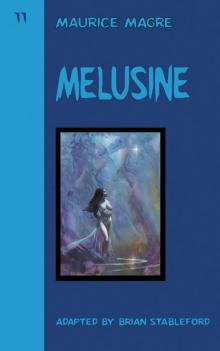 Melusine
Melusine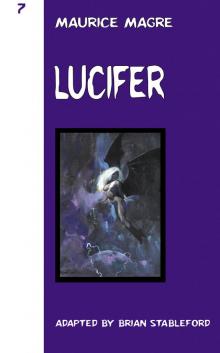 Lucifer
Lucifer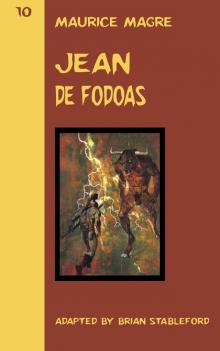 Jean de Fodoas
Jean de Fodoas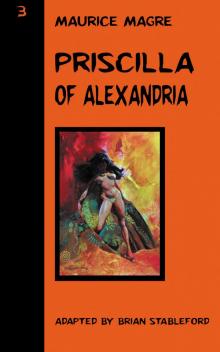 Priscilla of Alexandria
Priscilla of Alexandria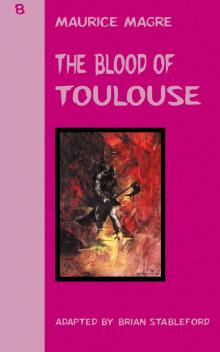 The Blood of Toulouse
The Blood of Toulouse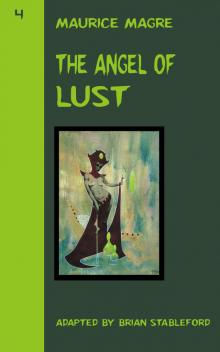 The Angel of Lust
The Angel of Lust